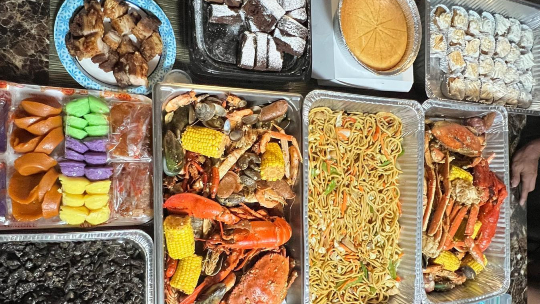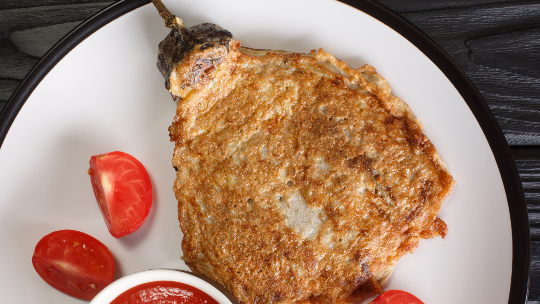The unique flavors of Filipino cuisine are so delectable they’re celebrated every April during Filipino Food Month. In honor of this festive time, Jeanalyn Dungca, HMSA account servicing advocate I, shared memories of her Filipino heritage and a healthy and delicious recipe she still prepares today. Learn how to make tortang talong, or Filipino eggplant omelet, from Dungca and why it’s a go-to dish in her home.
A full childhood
When she was a child, Dungca didn’t need an alarm clock. She’d wake up to the sizzle of meat cooking in the frying pan. “First it was the sound, then the smell,” she says. “My grandpa liked to make corned beef, eggs, and onions for breakfast. It’s still my favorite.”
Dungca has fond memories of growing up in Waipahu. “My grandparents moved here from the Philippines when my mom was 19 years old,” she says. “The house was full of people, and we were very family-oriented. It was loud, in a good way!” She lived with her mom, dad, siblings, grandparents, uncle, auntie, and cousins.
Though her grandfather, Ernie Tapat, was a full-time landscaper, he always made time to cook for the family. “The two most important things to him were family and food,” Dungca says. “He instilled family values and took care of others through food, and I’m so grateful to him.”

Dungca and her grandfather.
The list of Filipino dishes Tapat prepared is long, but his favorites included chicken papaya, garlic fried rice, ginisang sardinas (sauteed sardines), lauya (Filipino soup), lumpia, pinakbet, pork guisantes (pork and peas), and tortang talong. “He also made dishes that weren’t necessarily Filipino, but were staples for our family,” Dungca says. “He’d use tomato and onion in everything. It could be in a stir fry, soup, or dipping sauce.”

You can find a variety of food at Dungca’s family parties.
While English and Ilokano were spoken in the home, there was also a third language: food. “We can talk about food all day,” she says. “Especially now that my grandpa passed away. He didn’t leave a recipe book, so we’re always trying to figure out how he made his dishes. We’d watch him, of course, when he was alive, but he never measured. All his recipes came from his heart.”

Family and food.
New traditions
After Tapat passed away from colon cancer in 2023, Dungca’s family decided to have weekly Sunday dinners in his honor. “Everyone in the family brings a dish we think Grandpa would like,” she says. “It’s a way to keep his memory alive. He fed us for so many years; now it’s time to take care of each other.”
Now a mother to three children, Dungca spends a lot of time in the kitchen, just like her grandfather. “I love cooking and sharing my Filipino heritage through food,” she says. “I realized that there aren’t a lot of places to get authentic Filipino food, and if you’re not going to Filipino family parties, you don’t have the opportunity to try all of our delicious dishes. I feel so lucky cooking was such an important part of my childhood.”
Whenever she hosts parties, Dungca makes sure everyone has enough to eat. “I want to make sure people enjoy the food and have leftovers to take home,” she says. “I don’t even care if I eat, I can eat this food anytime!”
For spring break, her 9-year-old daughter had an assignment to cook something. “She’s always wanted to cook, so it was a good opportunity to try,” Dungca says. ”So, we taught her how to scramble an egg since it’s such a staple in Filipino cuisine. She did great! Now, she makes eggs for herself and her brothers. My grandfather, her great-grandfather, would be so proud.”

Dungca with her husband, children, and grandfather a few Thanksgivings ago.
TORTANG TALONG
Also known as Filipino eggplant omelet, tortang talong is a popular dish in the Dungca household. “This simple dish combines the fresh and light flavor of eggplant with the rich flavor of egg,” Dungca says. “Eggplant is a rich source of fiber, which not only benefits the digestive process but also helps to improve your heart health.”
Dungca serves this versatile dish for breakfast, lunch, or dinner!
Ingredients
- 2 medium Chinese or Filipino eggplant
- 3 eggs
- ¼ tsp. salt, to taste (may also use patis or fish sauce)
- ¼ tsp. ground black pepper, to taste
- 1 Tbsp. neutral oil for frying (vegetable, canola, peanut, etc.)
Instructions
Traditional eggplant preparation: Wash then dry any excess water. Grill the over gas stove or broil in oven until the skin is blackened and charred all over. Set aside.
Air fryer eggplant preparation: Air fry at 375 degrees F for 20 minutes.
Cool for at least 10 minutes. Peel off skin to expose the flesh, leaving the stem attached.
In a separate bowl, beat eggs, salt, and pepper until well combined.
Add the peeled eggplant into the beaten egg mixture. With a fork, flatten the eggplant by gently mashing it into a fan shape. Flip the eggplant to ensure even coating with the egg.
Place eggplant in an oiled pan and add half the remaining egg mixture on top. Fry over medium heat for 2-3 minutes or until the bottom of the egg has set. Flip and cook for 2-3 more minutes or until golden brown. Repeat for second eggplant.
Makan tayong, or let’s eat!

More food, more memories
Here are some simple and delicious recipes the whole family will love.
- black bean enchilada casserole
- cottage cheese loaf
- crispy taro fritters
- crunchy peanut and quinoa salad
- lemon broccoli pasta
- peanut coconut cauliflower curry
- stir-fried tofu with mac nuts
- stuffed cabbage rolls
- vegan chickpea burgers
- vegetarian kimchi stew
Photos courtesy Jeanalyn Dungca




